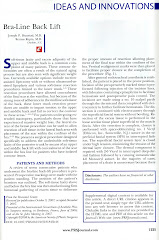What is muscle tightening?
There is a fair amount of confusion about the process of "muscle tightening" during the tummy tuck procedure। The key to understanding this process is understanding the anatomy of the abdominal wall। The basic idea is that the muscles of the abdominal wall are all covered or enclosed in a thick tissue cover called fascia. This fascia, in part, maintains the general position of the abdominal muscles to one another, especially the "six-pack" muscles in the midline.
With age, pregnancy, and weight fluctuation, the abdominal wall (muscles and fascia) stretch to accomodate these changes. As you may imagine, the muscles have an easier time returing to their previous size and shape. The fascia, however, may remain streched since it does not have the same contractile properties of muscles. This results in a persistent roundness of the abdominal wall which presents as a fullness or "pooch" especially on side profile.
The process of abdominal wall tightening is really the process of abdominal wall fascia tightening। This is why I prefer the term "myofascial plication". It best describes the process of tightening the abdominal wall. When performing a tummy tuck, during the process of myofascial plication, I plicate of tightent the fascial covering of the abdominal wall and by doing so the abdominal wall muscles are returned to their youthful, pre-pregnancy/weight gain position. This process can be better visualized as tailoring the fabric of a dress or pants to better fit the body. The extra cloth is hemmed or plicated so that it matches and follows the contour of the body, allowing a boxy or oversized shaped to be molded to the underlying silhouette.
To tighten or not to tighten: Is muscle tigtening (myofascial plication) always needed?
The short answer is no. Muscle tightening is a very important part of the tummy tuck procedure. It allows the side and front profile to be improved, making the abdomen look flat from the side and hour-glass from the front. Some patients may simply have excess skin and soft-tissue without laxity in the abdominal wall. These patients may not need or benefit from muscle tightening. My experience is that most people who are candidates for a tummy tuck are also good candidates for muscle tightening. Of course, this is based on the needs, goals, and desires of each individual. I simply give my recommendation as if it were my body and explain the pros and cons of muscle tightening, and allow the patient to make the final decision. The downside of muscle tightening is some extra discomfort and a bit longer recovery process to get back to full speed. I have found that 99% of patients choose to undergo muscle tightening when it is explained.
All the best,
Thursday, September 4, 2008
Subscribe to:
Posts
(
Atom
)







